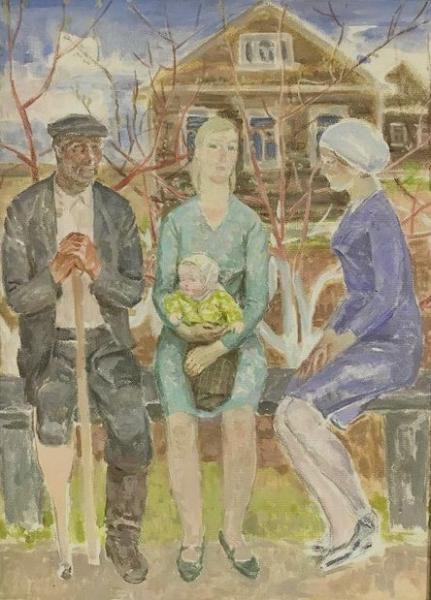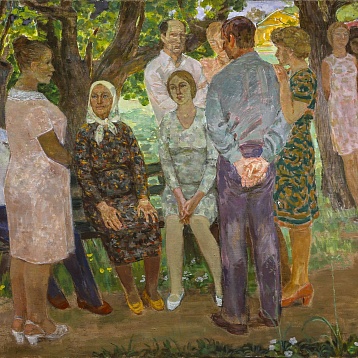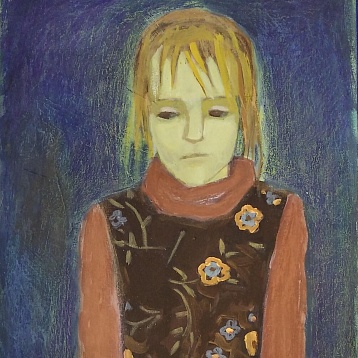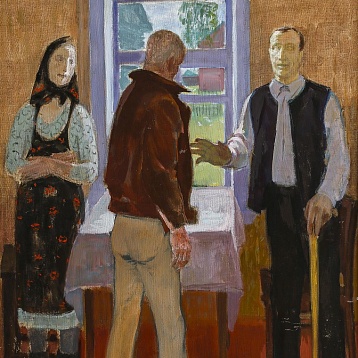



The Fathers and Children exhibition continues the series of "family exhibitions", when works by representatives of artistic dynasties are gathered in the museum space. This exhibition is dedicated to the work of three masters: Dmitry Vainman, Mikhail and Yelena Natarevich, whose talent revealed itself in their respective fields of arts.
Mikhail Natarevich, a painter working in tempera and oil, was one of the most outstanding representatives of Leningrad art school. His work is characterized by genre and thematic diversity, but whether these are historical-revolutionary compositions or depictions of rural everyday life, the most important to the artist always remained a human being, especially his or her existence in the context of family values. In the 1960s and 1970s Natarevich worked every summer on the Oredezh river near Leningrad, where the life of the modern village became a source of inspiration for him. It was in the village images that his deep poetic talent manifested itself first of all. In the paintings of that period one can easily discern the distinctive features of his artistic manner: attention to plasticity expressiveness of the composition, tendency to the generalization of form and colour, and decorativeness of pictorial structure. Transmitting the atmosphere of life of his contemporaries, Natarevich almost always avoided details, focusing on the plasticity of body as the most important method of expressing the character of a person. The Portrait of Pablo Picasso (1969) and Portrait of the Sculptor Naum Mogilevsky (1969), at the exhibition, stand apart in his art. They are distinguished by a different approach to the theme, expressed in the compositional structure and coloring, appealing to the work of the depicted artists.
The exhibition includes paintings from the 1960 –1970s, the most interesting and fruitful period of Natarevich's oeuvre, from the collection of the Museum of 20th–21st Century Art of St Petersburg, the artist’s family and private collections.
Dmitry Vainman is a contemporary St Petersburg sculptor who continues and develops the traditions of the School of Alexander Matveev. His professional formation was first and foremost shaped in the family where the atmosphere of creativity reigned. He inherited the artistic culture from his parents, Moisei Vainman and Maria Kharlamova, disciples of Alexander Matveev, who made a huge contribution to art. Working with such materials as wood, ceramics, bronze and stone, Vainman was able to cover a wide variety of sculptural genres, such as portraits, nudes, and compositions on various themes, coloured both in tragically sublime and poetic-romantic tints. Typical of him is attentiveness to relief, which becomes the continuation of the round sculpture. Very often the sculptor uses a combination of materials filling a wooden base with ceramics or bronze.
The exhibition includes works from different periods, reflecting the artist's versatility. These are portraits characterized by psychological profundity, nudes with their soft plasticity, relief compositions on Jewish themes and three-dimensional works related to theater and circus motifs. And all of them are the result of hard work and reflection on the nature of sculpture.
Yelena Natarevich, an outstanding contemporary artist, continues the traditions of Leningrad school of graphic art. Her oeuvre is an example of high professionalism and attention to the material, no matter in what technique she works. Natarevich's works are distinguished by a balanced restraint in the presentation of thematic and figurative content, typical of Leningrad school, even in the simplest subjects drawn from the life observed. No matter what theme Natarevich addresses, her compositions and portraits always have a lyrical tone. The artist loves her heroes, admires rural and urban landscapes; she is inspired by objects of everyday life. Everything she depicts is recognizable, the images she creates one can discern the atmosphere of time. In a rich variety of graphic and painting techniques used by Natarevich in her work, a separate place belongs to collages, in which compositional rigor is combined with sophistication of coloristic solutions. At times almost monochromatic, at times shining with bright local colors, Natarevich's collages are an example of impeccable artistic taste, creative energy and concern in the approach to theme.
The exhibition reveals almost all facets of Natarevich's art. Portraits, landscapes, thematic compositions and still-lifes, executed in acrylic paints, gouache, watercolor and collage techniques coexist within the exhibition.




